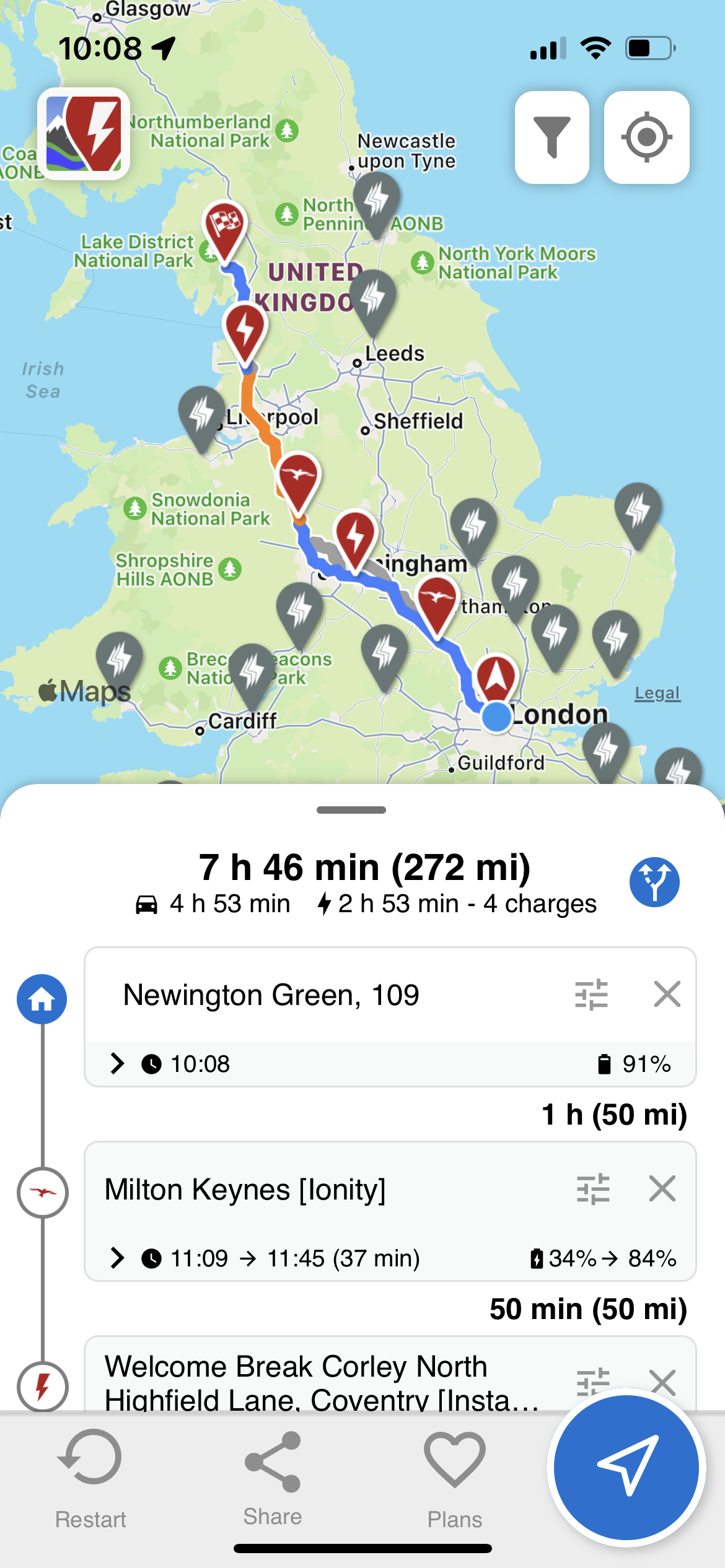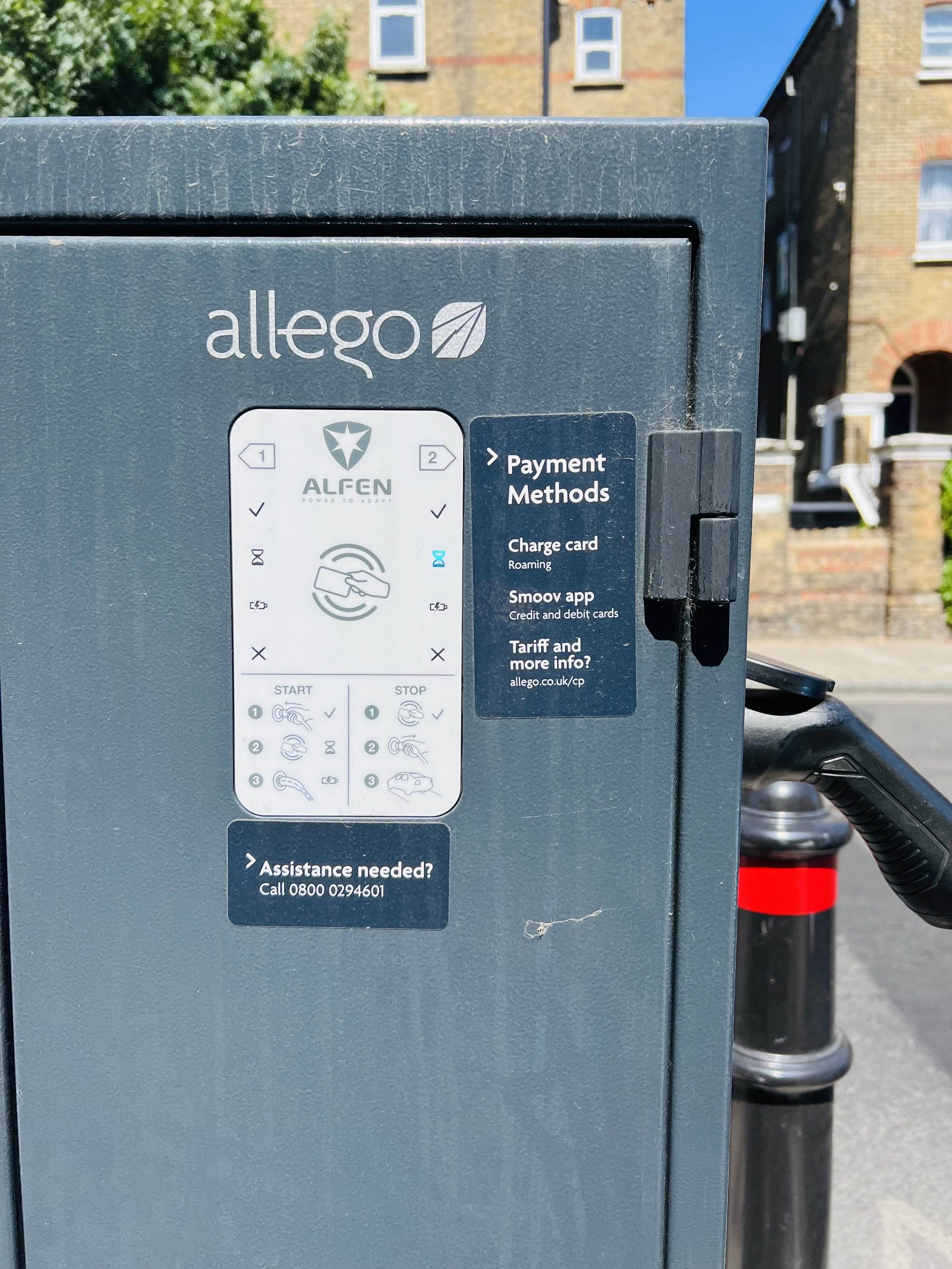Range Anxiety is Bullshit - Part 1
An interaction designer's view on driving electric cars – the Fiat e500 and others over 6000 miles around UK
Kentmere, Lake District
TLDR
Contrary to the many myths and presumptions about electric cars, my experience driving an EV has been relatively smooth and convenient, with its range not causing me any real anxiety. I found a change of mindset around driving EVs and some planning (recommendations below) can go a long way towards a calm mind. However, what surprised me most is that there are some pretty basic challenges that most vehicle manufacturers (and/or charge networks) haven't yet solved that could drastically improve the experience.
This Part 1 looks at the experience of driving an EV, and Part 2 looks at the challenges and what opportunities lie beyond them.
ICE twat parked in the EV charging bay
Lordship Park, London
Context
About Me
I'm an ultra runner living in North London.
My weekly journeys are around 12 miles long – taking my wife and two dogs to parks and driving out to the hills/woods for training. On weekends my training takes me to Box Hill (120 miles round-trip) or Chilterns (80 miles round-trip). Once a month, I usually drive out to the Brecon Beacons (190 miles one way) or The Lake District (300 miles one way) for a long weekend of running, where I'll camp/sleep/eat in the car.
Happy Peter, running in Brecon Beacons
Last 3 years, my car was a diesel Ford Transit Connect van that I've converted. I also drive across Europe to Slovenia twice a year to visit my family (around 1000 miles one way).
My ex-car: self converted Ford Transit Connect
One of my many trips to the Lake District
Our whippets playing at Camber Sands
I work as an interaction designer and prototyper at Normally, a data research and design studio. I've worked on interactive maps for Heathrow airport, complex dashboards for clients like Meta and JATO Automotive and built interactive art installations for places such as the Carinthian regional museum.
About the car(s)
Fiat 500e (back), Honda-e (left) and Kia Niro EV (right)
In August 2022, we hired an electric Fiat 500e that we used exclusively for all our journeys until October (over 1500 miles). As I was going to get a new car anyway, I've used the opportunity to test drive a whole bunch of EVs and have "replaced" the van now with a Kia Niro EV 🙀. My wife has also since bought a Honda-e for her business, Dogsnug (handmade dog accessories based in London).
At the time of writing:
Niro EV (real-world range around 260miles)
Has 3000 miles on odometer
Honda-e (real-world range around 110 miles)
Has around 400 on odometer
Fiat 500e (real-world range around 160 miles)
Has around 1500 on odometer
Part 1: My Experience
Let's talk about range
The Fiat 500e does not have a massive range. Realistically we were getting around 160miles when charged to 100% – a combination of 2/3 motorway and 1/3 city driving.
We didn't find this a problem as most of our trips in London are around 10-15 miles, and when travelling further, we've always found places to charge.
Fiat 500e infotainment – charge settings
Rugby services charging stop
Longer trips with EV
On longer trips (travelling to Lakes District – 270 miles away), we were more limited by the range of my bladder than the car's battery. We recharged 2x on the way and plugged the car in when we arrived at the supermarket.
The sessions usually took around 20-25 minutes to get us from roughly 20% to 90% charged on rapid chargers at service stations.
Trips to the south coast (Camber Sands 80miles away) would have required us to charge 1x on the way back.
Infrastructure is good but could be much better
In London, there are thousands of chargers to choose from. Within 1 mile radius around our house, there are over 50 chargers. Four of these are rapid chargers (>50kw/h), perhaps a 10min drive away. Six are slower chargers (22kw/h) but are working, reliable, and conveniently close (around the corner and/or next to a lovely hipster cafe).
Since it's good practice to charge at low speeds to preserve battery health, this works well for us as I can plug the car in when we get home from our morning runs and pick it up around lunchtime when I walk with the dogs again.
PB Pulse 50kWh charger near Finsbury Park
On-street lamppost charger charger
22kWh charger with EV parking bay In front of Hackney 215 Café
Even in more rural places like the north of England (Cumbria), we found rapid chargers available at least every 10miles or so (Windermere, Kendal, Keswick, Penrith, etc.) and quite a few slow chargers scattered around (Staveley, Grasmere, etc.).
Instavolt charger at Booths supermarket, Kendal
Charging at Staveley Mill Yard, Staveley Lake District
However, I have seen charging stations running out of chargers quickly during morning & evening rush hour and queues forming. This can be a real pain if you're in a hurry. Although one design solution would be better visibility of the nearby available and working rapid chargers, realistically, this needs to be addressed at an infrastructure level – build more reliable, rapid chargers.
EVs cueing at Ionity at Beaconsfield services whilst my Kia Niro EV is charging
Planning is essential
The number one tip I would give any new EV owner is to look up where "good" chargers are and save their locations on a map/notes/elsewhere so that you can quickly send them to your navigation when needed.
My saved fast chargers in Google Maps
There are two kinds of "good" chargers I recommend looking for:
Fast chargers
Also called rapid chargers – to use on longer trips: Speeds of 50kW/h or faster, high user rating, multiple 3+ spaces or connectors available, close to amenities such as coffee/toilets.
Gridserve Rugby
Touchscreen interface, contactless payment, CCS Cable attached
Slow chargers
Slower destination chargers to plug in at destinations where you're staying, around the home, or places you often visit: speeds around 11-22kw/h and a high chance of being available most of the time.
Dragon charging Wales
No interface, no contactless payment, bring your own type 2 cable,
ChareMap Screenshot: Chargers around Stoke Newington (Nov 2022)
Purple: Rapid (50kW/h+)
Red: Slower (22kW/h)
Orange: Slowest (3-7kW/h)
I am a map geek (see some of my design and interactive work), so viewing/testing different apps' maps and making notes was naturally enjoyable to me, but even if you're not, it's an excellent skill to learn.
This will save you endless potential headaches and, to a large degree, alleviate any anxieties you might have about running out of range. If you research beforehand, you'll know exactly where you can get the juice and where potential backups are if specific chargers don't work or are occupied. No stress.
Apps I would recommend downloading
ZapMap
ZapMap (UK only) has the most comprehensive list/map of all the chargers in UK. The interface is pretty "engineery", but it works. It's community-driven, so members (including you) can review charging stations and suggest edits when needed.
ChargeMap
ChargeMap, also community-driven, is two things: an app similar to ZapMap that shows you where chargers are and a service that provides you with one charge card with which you can charge on various networks. As an app, it's got a much better interface than ZapMap but sometimes misses a charger here or there (tested only in the UK). As a service, it will provide you with one charge card that you can use to charge at various networks instead of needing a different silly app for each provider. It works with more networks than zap-pay.
ABRP
ABRP (A Better Route Planner) will help you plan longer journeys by recommending places to charge. It has a comprehensive collection of rapid chargers, and its suggestions of where to charge are great. You can even select networks you'd want it to prioritise if you've got a membership for a "charge card" (f.ex. Ionity or BPPulse).
Provider, app and charger interaction hell 🤬
What surprised me most was that it isn't the lack of chargers being the most painful part about owning an EV, but how inconsistent the charging infrastructure is and the huge variety of networks, apps and charging methods there are.
There are 7 different providers managing the chargers within a mile of our home. Each has its own app and interaction model (sequence) of how you go about plugging in the car. With some, you'll have to open the app first, select charger, and then plug the car in. Others want you first to plug the car in and then scan a QR code, etc. Imagine having a different way of putting petrol into your ICE car at each service station 🤯
Some services like ChargeMap or ZapMap will give you a physical (NFC) charge card that allows you to charge your car using 1 card at several different chargers. More and more vehicle manufacturers are starting to provide similar services (Kia Charge, Mercedes me Charge, etc.). However, none cover all the networks and none work 100% of the time. In my experience, ChargePass and Kia Charge cover about 1/3 of all the chargers I like to charge at and have worked for me about 80% of the time.
Download all the apps
More on this in Part 2; for now, I recommend downloading each of these apps, registering, and putting your card details in at home when you've got a good internet connection. And it's not raining. Then go and try out different charging interaction models/procedures so you get used to them.
This sounds really bad, but once you've experienced 4-5 different ways of plugging in the car and found your preferred networks/chargers, you'll be able to recognise the patterns quite quickly and deal with them with little stress.
The surprising convenience of driving an EV
My Niro EV charging at a supermarket
Driving an EV changed how I think about refuelling a car. Instead of actively making the journey to the petrol station, I often catch myself "passively" plugging the vehicle in at the supermarket, near the park we go to or in the town we visit at the weekend. Although these chargers "along my way" might not be rapid, they make it very convenient for me to top up the battery as a natural part of my day. If we owned our house, we could also install a wall charger at home, removing the need to charge the car at a public charger around 90% of the time.
I also often plan trips (or specifically where to park) around where chargers are, so I can plug in when arriving at destinations (more on opportunities this opens up in Part 2).
Conclusion
All in all, my experience driving an EV has been very positive. The ride's smoothness, the engine's silence, and the lack of smelly fumes coming out of the exhaust all make for a great driving experience I would highly recommend to anyone considering. My journey so far has not been without hiccups. In Part 2 I offer some ideas towards solutions. However, for me, the benefits and the comfort far outweigh the challenges.




























